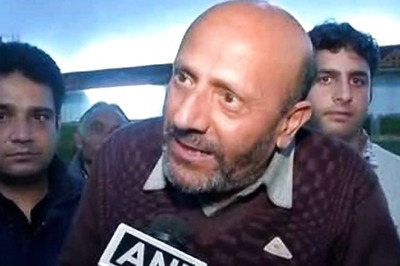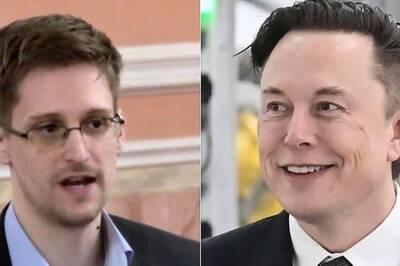
views
I went to the Jaipur Literature Festival (JLF) this week to participate in the final closing debate. The topic for the debate was ‘The Right and Left Divide Can Never Be Bridged.’ I spoke against the motion. Priyanka Chaturvedi, the Shiv Sena Rajya Sabha MP from Maharashtra and Makarand Paranjape, academic, writer and former Director of the Indian Institute of Advanced Studies, Shimla, were also against the motion. Supporting the motion were Jawahar Sircar, Trinamool Congress (TMC) Rajya Sabha MP, Purushottam Agarwal, scholar and author, and Vandana Shiva, one of the world’s most admired environmental activists. It was an animated and highly charged debate, egged on by a huge audience. All the speakers spoke passionately. I am giving below my own reasons on why I opposed the motion and the readers are free to agree or disagree.
My fundamental point was that the labels ‘Right’ and ‘Left’ are Western constructs. India must forge its path, in accordance with the fundamental constructs of our own civilisational history. The famous Mahāvākyas or great sayings of our ancient texts speak of the importance of seeking unity while accepting the reality of diversity. The Rig Veda stresses ‘Ekam satya vipra bahuda vedanti’ (The truth is one, the wise call it by different names). The same text also emphasises ‘Aano bhadra krtvo yantu vishvatahah’ (Let noble thoughts flow from all directions’). At the entrance to Parliament is inscribed the remarkable saying from the Maha Upanishad: ‘Udaar charitanam vasudhaiva kutumbukam’ (For the big-hearted, the entire world is a family).
Given this worldview, for us, the approach must be to see how to synthesise the divergence of opinions, without stifling legitimate differences of views, dissent and disagreement. Not everything is good in the Right political spectrum, nor is everything bad in the Left. Our aim is to find a bridge so that what is wrong on either side is rectified, and what is good is further improved, in the interests of the overall good of the nation and its people.
I gave several examples to show how such bridges have been built in the past. The Rashtriya Swayamsevak Sangh (RSS) was banned by the Congress in the 1950s, for the right reasons. But when the same RSS did praiseworthy work in assisting the government during the 1962 war with China, Jawaharlal Nehru, the socialist first Prime Minister of India, invited a contingent of the RSS to participate in the Republic Day Parade of 1963. Veer Savarkar’s polemic on the creation of a Hindu Rashtra, written in 1923, must be rejected outrightly in our plural and multi-religious Republic. But there can be little doubt that he was a revolutionary freedom fighter who paid a very high price for his patriotism by spending 11 years in the dreaded kala pani jail in the Andamans. In recognition of that, it was the socialist PM Indira Gandhi, who released a postage stamp to honour him. When the Emergency was imposed by Indira Gandhi in 1975, it was the RSS that played a vital role in working to fight it, and its contribution was acknowledged by no less than the socialist and Gandhian leader, Jayaprakash Narayan.
Apart from such bridges, there are practical examples of how the black-and-white divides between the Right and Left have dissolved. In 1977, the right-wing Jan Sangh, the precursor to the Bharatiya Janata Party (BJP), joined hands with left-wing parties to form the Janata Dal. Both were anathema to each other, but political expediency brought them together. In 1991, when the Congress government brought in far-reaching ‘right wing’ economic reforms to dismantle the license raj of the socialist years, Finance Minister Manmohan Singh, in his speech in the Parliament, justified the reforms on the grounds of promoting the socialist vision. Similarly, the right-wing BJP in the Opposition opposed the ‘socialist’ MNREGA programme of the Congress party, only to bring MNREGA back when it came to power.
Neither the Right nor the Left are infallible or anywhere close to being blemish-less. I have seen repugnant right-wing dictatorships and also left-wing tyranny. Therefore, to say that only one ideology alone must prevail, is to live in a delusional world. Our aim must be to fight what is wrong and not vilify what is right on the basis of ideological convenience. Our civilisational ethos is one of dialogue, where we must stand by our principles and fight against anything that is against democracy and freedom, and the principles enshrined in the Constitution, but not consider that one side alone has a monopoly on truth.
Shastrartha, or civilised discourse, needs to be pursued even when it may appear unbridgeable. That is why, personally, I admire both- the right-wing Atal Bihari Vajpayee and the left-wing creator of modern India, Jawaharlal Nehru. That is why I also supported the visit of Pranab Mukherjee to the RSS headquarters in Nagpur after he had demitted the office of President of India because our civilisational ethos does not practice political ‘untouchability’. That is why, in the eighth century CE, Adi Shankaracharya, who followed the jnana-marga, or the path of knowledge, had a shastrartha with his avowed opponent, Mandana Mishra, who was a proponent of karma kanda, or action as prescribed by the Vedas. Through dialogue, they found a synthesis.
Ultimately, the difference of opinions and freedom to dissent is a non-negotiable aspect of democracy. They need to be strengthened. But absolute divides, which nullify the possibility of dialogue and accommodation to the extent possible, are often self-defeating. The interests of the poor, the vulnerable, the deprived, and the overall good of the nation are the paramount goals. This is what should unite us and bring the best of the Right and the Left together in the greater national interest. We should not forget that it was a Chinese communist leader, Deng Xiaoping, who famously said: ‘It does not matter whether the cat is black or white, so long as it catches mice’.
The author is a former diplomat, an author and a politician. The views expressed in this article are those of the author and do not represent the stand of this publication.
Read all the Latest Opinions here



















Comments
0 comment